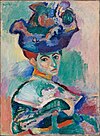Raoul Dufy
You can help expand this article with text translated from the corresponding article in French. (July 2020) Click [show] for important translation instructions.
|
Raoul Dufy | |
|---|---|
École nationale supérieure des Beaux-Arts | |
| Known for | Painting, drawing, design, printmaking |
| Notable work | La Fée Electricité (1937) |
| Movement | Fauvism, Impressionism, modernism, Cubism |
Raoul Dufy (French: [ʁa.ul dy.fi]; 3 June 1877 – 23 March 1953) was a French
printmaking, book illustration, scenic design
, furniture design, and planning public spaces.
Biography
Early life
Dufy was born in
Ingres. There he met Raimond Lecourt and Othon Friesz, with whom he later shared a studio in Montmartre and maintained a lifelong friendship. During this period, Dufy primarily painted Norman
landscapes in watercolors.
In 1900, after a year of military service, Dufy won a scholarship to the
Fécamp, on the English Channel (La Manche), with his friend Albert Marquet
.
Later years
stenographic. In his oils and watercolors, he frequently depicted contemporary scenes, including yachting events, elegant social gatherings, and views of the French Riviera. For the 1937 Exposition Internationale
in Paris, Dufy produced "La Fée Electricité," one of the largest paintings of its time, an expansive and widely acclaimed work celebrating electricity, executed in oil on plywood.
Dufy also acquired a reputation as an illustrator and commercial artist. He painted murals for public buildings and produced a significant number of tapestries and ceramic designs. His plates appear in books by
patterns for Bianchini-Ferier, which were used for garments worn by Poiret and Charvet. The Bois de Boulogne is a dress that was designed by Paul Poiret, textile design by Dufy, and textile manufactured by Bianchini-Ferier. Dufy had a bold and graphic design approach that reflected Paul Poirets' personal preference and style. Both, Poiret
and Dufy, would come together many times to create many new designs.
In the late 1940s and early 1950s, Dufy exhibited at the annual
Nice
.
Collections
Among the public collections holding works by Raoul Dufy are:
- Art Institute of Chicago, Chicago, IL, USA[1]
- Art Gallery of Ontario, Ontario, Canada
- Kalamazoo Institute of Arts, Kalamazoo, MI, USA
- McNay Art Museum, TX, USA[2]
- Musée d'Art Moderne de Paris, Paris, France
- Musée des Beaux-Arts de Nice, Nice, France
- Museum de Fundatie, Zwolle, Netherlands
- National Gallery of Art, Washington, D.C., USA
- Unterlinden Museum, Colmar, France (Pink Nude, 1930)
- Van Abbemuseum, Netherlands
- Virginia Museum of Fine Arts, Richmond, VA, USA
Selected works
-
Les Alliés (1914)
-
Le Cavalier arabe (Le Cavalier blanc) (1914), Musée d'Art Moderne de Paris
-
Hotel Sube (1926), The Phillips Collection
-
Regatta at Cowes (1934), National Gallery of Art
Works
- Hommage à Mozart Archived 2007-10-25 at the Private Art Collection)
- Le 14 juillet au Havre, rue pavoisée Archived 2007-12-17 at the Private Art Collection)
- Trees in L'Estaque, 1908 oil on canvas painting[3]
- French modern art exhibition 1939 treasure 3 National Library of Latvia displayed via The European Library
- Works by Raoul Dufy (public domain in Canada)
- Raoul Dufy's artworks in context, Museum of modern art André Malraux
Illustrations
- Jean Cocteau, Bertrand Guégan (1892-1943); L'almanach de Cocagne pour l'an 1920-1922, Dédié aux vrais Gourmands Et aux Francs Buveurs[4]
See also
References
- ^ "Raoul Dufy | The Art Institute of Chicago". The Art Institute of Chicago. Retrieved 2023-09-16.
- ^ McNay Art Museum (2014). "McNay Collection: Raoul Dufy". Mcnayart.org. Archived from the original on 19 August 2016. Retrieved 16 May 2016.
- ^ "Catalogue entry".
- ^ ^ Princeton University (14 June 2017). "Edison turns up in Paris". Retrieved 2022-01-12.
^ Tourlonias, Anne (1998). Raoul Dufy, l'œuvre en soie (in French). Avignon: Barthelemy. p. 41. ISBN 978-2-87923-094-8. Le 1er mar 1912, Raoul Dufy et Charles Bianchini signent le contrat. ^ Hay, Susan (1999). From Paris to Providence, Fashion, Art and the Tirocchi Dressmakers' Shop, 1915–1947 ("Modernism in Fabric: Art and the Tirocchi Textiles"). Rhode Island School of Design. ^ Raoul Dufy: Paintings, Drawings, Illustrated Books, Mural Decorations, Aubusson Tapestries, Fabric Designs and Fabrics for Bianchini-Férier, Paul Poiret Dresses, Ceramics, Posters, Theatre Designs. London: Arts Council of Great Britain. 1983. p. 106. ^ Harris JC (2010-04-01). "LA cortisone". Archives of General Psychiatry. 67 (4): 317.PMID20368507. ^ health.com. "11 Famous People With Rheumatoid Arthritis". Archived from the original on 2013-04-06, retrieved 2013-02-23. ^ McNay Art Museum (2014). "McNay Collection: Raoul Dufy". Mcnayart.org. Archived from the original on 19 August 2016. Retrieved 16 May 2016. ^ Notice WorldCat; sudoc; BnF. Engraved on wood and unpublished drawings of Matisse, J. Marchand, R. Dufy, Sonia Lewitska, de Segonzac, Jean Émile Laboureur, Friesz, Marquet, Pierre Laprade, Signac, Louis Latapie, Suzanne Valadon, Henriette Tirman and others.´
External links
 Media related to Raoul Dufy at Wikimedia Commons
Media related to Raoul Dufy at Wikimedia Commons





